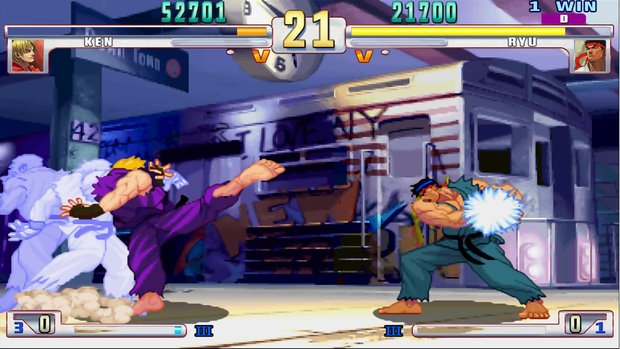Street Fighter 5 is a brilliantly casual game
“Again? God! Come on!” I yelled, tossing my hands in the air, brandishing my PS Vita one-handed like a fussy old drunk shaking his betting slip at a losing horse at the track. My wife looked at me, a patient but equally irritated look on her face. “Sorry. Street Fighter 5. This dude’s real good with M. Bison. Geez.” She looked at me, clearly questioning her life choices, as I turned my face back to the PS Vita.
This exact scenario has been playing out pretty much nightly since Street Fighter 5 came out. Sometimes I win, often I lose. I am always smiling. Even playing on a Vita with only four readily-accessible buttons for attacking, even with a shaky remote play connection or the infrequently unstable online matches, it remains an engrossing game of timing, skill and glorious art. If that description makes Street Fighter 5 sound like a game that isn’t purely for serious competitors or people that have been playing the series for 20 years, that’s because it is. It is the most casually accessible fighter I’ve played since Street Fighter 2.
Clarity, not simplicity, is what makes Street Fighter 5 so instantly welcoming to someone not putting in eight hours per day studying every character for tournament play. For the past two decades, every new Street Fighter has attempted to gussy up its original premise to offer greater variety to players. The natural result is greater complexity. Street Fighter Alpha 3 added three different styles of super combo moves for each character, Street Fighter 3 the ability to parry by moving the joystick at painstakingly precise moments, and so forth. For players that want to exhaustively study the differences between R. Mika’s X-ism and A-ism styles or every single attack in Oro’s arsenal, those changes were mana from heaven. Serious players welcomed embellishments on the old Street Fighter 2 model of a character with basic attacks and a few special moves. For anyone that wanted to dive right in and just play, especially with other players, the barrier of entry rose higher and higher.
Street Fighter 4 initially tried to pare down these intricacies, to harken back to Street Fighter 2. “We want it to feel like a homecoming,” said producer Yoshinori Ono back in 2007, “for it to be natural and instinctive for users to return to.” By the time Ultra Street Fighter 4 came out, there were 44 different characters all with multiple Ultra Combos and regular Focus Attacks and Red Focus Attacks and cripes it’s exhausting just thinking about it. If you didn’t know what a freaking Dash Cancel was, Street Fighter 4 became just as impenetrable as entries like Street Fighter 3.

Street Fighter 5, meanwhile, does indeed feel like a homecoming. All 16 of its initial characters feel distinct from one another, both visually and in terms of basic movement, so it’s easy to become familiar with them within minutes of playing. Rather than broadly generalized systems like Street Fighter 3’s parries or 4’s tide of different super moves, Street Fighter 5’s awkwardly named V-skills and V-triggers still equate to extra, character-specific maneuvers. They’re just something else that helps distinguish a character, letting you easily get to know them. Pulling off a V-skill is as easy as tapping two buttons at once and seeing what happens. There’s still a learning process, but everything you see happening on screen feels instantly tied to what you do with the controller. Everything is clear. The barrier hasn’t been removed entirely so much as it’s been lowered to the point where you can plainly see what’s happening on the other side.
It feels great. I adored playing as Cammy in the days of Super Street Fighter 2 and X-Men vs. Street Fighter, but drifted away from the character more recently. How she fit inside the grand machine of Street Fighter 4 just didn’t make any sense to me. Red Focus Attacks? What? Sitting down with Street Fighter 5, though, she felt familiar, but renewed. Even just the basic movement in the new game feels more grounded and transparent. If I hold forward and tap the strongest kick, Cammy will do a sweet skipping knee kick, but if I don’t hold forward, she’ll do a roundhouse. Got it. Meanwhile, her classic lunging punch move is now a V-skill, so I just have to tap two buttons to pull it off rather than some tricky joystick motion. Perfect.
That kind of clear execution makes it far easier to focus on what another fighter is actually doing and far easier to be patient and follow what’s happening on screen. With the pressure off of having to constantly decode all the different systems and whatnot happening on screen, it also becomes easier to just enjoy a match even if there’s not a pitch perfect internet connection. Playing on a Vita, the stream from the PS4 in my home can occasionally get a little chunky and slow. Street Fighter 5’s a lucid enough game that I can compensate and just remember to keep blocking when there’s a hiccup in the connection. Even when the connection is perfect and I’m facing an opponent with a stack of ranked battle wins under his belt, I don’t feel completely lost inside his overwhelming skill. I can interpret what he’s doing on screen fully; I can fight him casually and learn from it.
Sign up to the GamesRadar+ Newsletter
Weekly digests, tales from the communities you love, and more
Marketing transformed casual into a dirty word in video games last decade, a term ultimately used by the gaming community to deride both certain players and certain games as less than worthy. Casual accessibility is something great games should aspire to, though. After decades of thickening inclusiveness, Street Fighter 5 has successfully invited people back into the fold. Its art, its elegantly balanced characters with their crisply defined abilities, all speak clearly on the screen to the player. No fightstick needed, no rarified knowledge of how to dash cancel into a V-ism whatsit, and no reason to get huffy about a shaky connection. It’s just fun to touch, to try, to test. It’s been a long time since you could say that about the fighting series that started it all.



